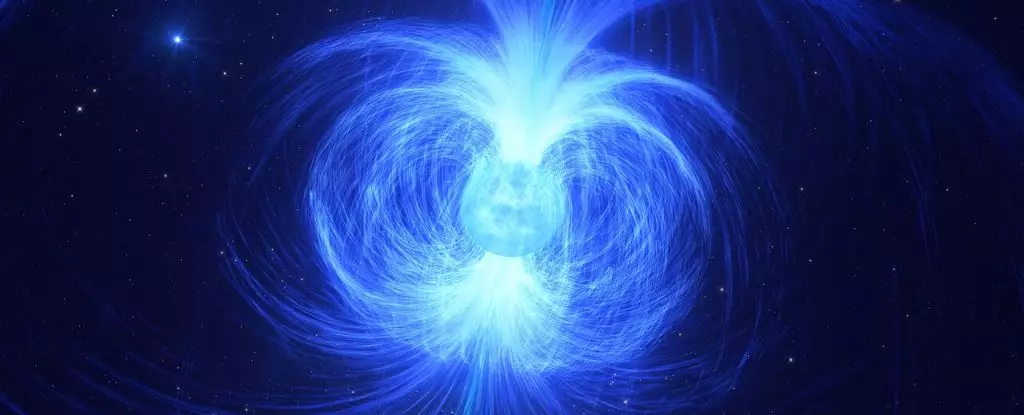In a remarkable advancement in astrophysics, astronomers have unveiled new insights regarding fast radio bursts (FRBs), particularly through the lens of the enigmatic FRB 20190208A. This occurrence, which once appeared to be a transient blip in the cosmic symphony, has led researchers to a faint dwarf galaxy located billions of light-years away. Such a discovery is not merely a routine account of cosmic phenomena but a testament to the complexities of the universe. Danté Hewitt and his team from the University of Amsterdam have unraveled a scenario that defies previous assumptions — a seemingly lesser mass dwarf galaxy hosting one of the most powerful astronomical signals we’ve observed. This observation signifies a shift in our comprehension of where these powerful signals originate.
The rarity of detecting FRBs in faint, lesser-known host galaxies raises thoughtful questions about their origins. The prevailing wisdom posited that these brilliant bursts stemmed from massive star-forming galaxies. However, the discovery of a modest galaxy as FRB 20190208A’s host challenges this notion and beckons a reevaluation of the cosmic environments conducive to the production of these bursts. It amplifies the message that the universe operates on principles that we are only beginning to understand.
Fast radio bursts are striking phenomena; they manifest as brief but intense spikes of radio waves, each releasing energy equivalent to hundreds of millions of suns in mere milliseconds. Their unpredictability makes them incredibly difficult to trace back to their cosmic origins. Most FRBs behave like fleeting whispers in the vast cosmos, flaring just once and leaving little trace. A smaller subset, however, exhibits repeated activity, allowing astronomers to study them with increased rigor. These characteristics have led to various theories, with some researchers attributing these bursts to the activities of magnetars — highly magnetized neutron stars that result from the explosive deaths of massive stars.
The complex nature of FRBs necessitates continuous observation and study, particularly of those emitting multiple signals. The ability to analyze events like FRB 20190208A helps build a more nuanced understanding of the underlying mechanisms. It has become clear that the search for answers is not a straightforward trajectory but rather a winding path through cosmic mysteries laden with surprises.
Hewitt and his research team monitored FRB 20190208A for an impressive 65.6 hours over the span of several years, ultimately tracing its origins in the least expected locale. The challenge lay not only in pinpointing the source but in what they encountered during their research. Initially, their efforts to find a host galaxy yielded nothing; it was a puzzling and disheartening period. However, persistence paid off when the Gran Telescopio Canarias revealed a faint image, confirming the existence of the mysterious galaxy.
What’s truly fascinating is that this dwarf galaxy, significantly fainter than typical FRB host galaxies, suggests potential underlying mechanisms that warrant further exploration. The faintness of this dwarf galaxy may imply that environmental factors distinct to such galaxies, such as low metallicity, play an important role in the formation of specific types of FRBs. As these low-metallicity environments host the most massive stars, their subsequent deaths mark a crucial step in this celestial narrative.
Interestingly, there is a noticeable trend: repeating FRBs are more frequently associated with dwarf galaxies compared to their one-time counterparts. This observation could reflect observational biases, but it could also hint at the unique conditions that dwarf galaxies present, which are favorable for producing these repeated bursts. The notion that a galaxy lacking the abundant star formation of larger galaxies could harbor magnetic phenomena or stellar deaths leading to FRBs provokes a reevaluation of our understanding of stellar evolution and the cosmic conditions that prevail in our universe.
Furthermore, the notion that the most massive stars in these dwarf galaxies explode into supernovae, giving rise to magnetars, opens a myriad of exciting possibilities. The idea that these celestial remnants could continuously emit FRBs post-explosion not only provides insights into stellar life cycles but ties the origins of these bursts to fundamental processes within galaxy formation and evolution. The cosmic tapestry is woven with the threads of life, death, and rebirth, and the implications of such relationships are profound.
The intricate relationship between dwarf galaxies and FRBs serves as a reminder of the vast unknowns that populate our universe. Each revelation in this field pushes us closer to a fuller understanding of these cosmic enigmas. As astronomers continue to deepen their observations and refine their techniques, like the combined use of radio and optical telescopes, we inch ever closer to deciphering the origins and mechanics behind fast radio bursts.
Hewitt’s sentiments about needing precise positional data and deep imaging strike at the heart of future astronomical research. As we reinforce our array of observational tools and techniques, the hope is not merely to catalog FRBs but to uncover the fundamental cosmic processes that underpin these astonishing signals. This journey of discovery continues, and it is precisely these enigmas that render the pursuit of understanding the cosmos both challenging and exhilarating.

